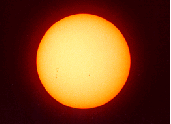

The Mercury Transit of 7 May 2003
Belgium, observation location 50,717 W 4,217 E


|
The Mercury Transit of 7 May 2003
|
|
Observing
|
Observing the transit The transit can been seen with a telescope fitted with a good solar filter or with a bincocular using the projection method. Telescope and solar filter
Binocular and projection
Altough this method is extremly simple, good results can be achieved. Some sites will tell you can't see
Mercury this way. Don't believe it. I tried it om 7 May 2003 with a 12x50 binocular. Mercury was only a
faint dot but no mistake was possible.
To be safe this should be tested a few day's before the transit around the same time, just to be sure you picked a good location and you know how to focus your image. On the day of the transit you only need good weather. Look for a small black dot. There should be no confusion with sunspots. Mercury's shade is round with sharp edges, sunspots are irregular and hazy. After some time you will have to more your binoculars so it keeps pointing to the sun. It's a good idee to draw the image of the sun on the carton board and indicate the position of Mercury. Repeat it after some time, you can plot the trajetory Mercury is taking across the Sun.
Tips
|